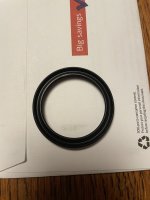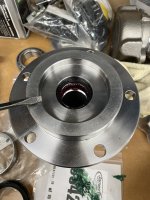- Joined
- Nov 3, 2003
- Messages
- 47,483
Mike's torque on the upper sleeve is probably gleaned from years of experience, but the "by the book" torque is actually 40lbs on the adjusting sleeve.
The issue I mentioned earlier with the sleeve coming out the bottom is why I also ended up going with less torque than specified in the book, because it was no longer working. The is possibly what he's adjusting for as well. Either that, or he's got a service manual that shows a different torque setting.
But did you also notice that he stated that after the final torquing of the upper nut, the pull on the scale got lighter? This is why the books specify checking the pull force AFTER the assembly is finalized.
But his method of checking first is probably even better, and lets you fine tune things based on your experiences with your particular front axle. Just as long as you measure your pull strength after the final torque of the upper nut to verify that it's "less than 26lbs" of force.
If someone has a factory manual handy, it would be nice to confirm. Since the Chilton's paperbacks were often riddled with small mistakes, and the Hayne's version that I have does not even address ball-joints, it would be nice to have another reference. Maybe the 40lb rating on the sleeve from the Chilton's is incorrect.
Paul
The issue I mentioned earlier with the sleeve coming out the bottom is why I also ended up going with less torque than specified in the book, because it was no longer working. The is possibly what he's adjusting for as well. Either that, or he's got a service manual that shows a different torque setting.
But did you also notice that he stated that after the final torquing of the upper nut, the pull on the scale got lighter? This is why the books specify checking the pull force AFTER the assembly is finalized.
But his method of checking first is probably even better, and lets you fine tune things based on your experiences with your particular front axle. Just as long as you measure your pull strength after the final torque of the upper nut to verify that it's "less than 26lbs" of force.
If someone has a factory manual handy, it would be nice to confirm. Since the Chilton's paperbacks were often riddled with small mistakes, and the Hayne's version that I have does not even address ball-joints, it would be nice to have another reference. Maybe the 40lb rating on the sleeve from the Chilton's is incorrect.
Paul














